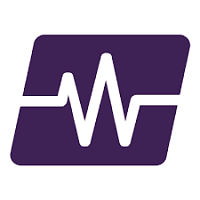Best Server Monitoring Tools and Software
Best server monitoring tools available in the market are Observium, Datadog, and Panopta. These server management software solutions track and monitor the server performance, and identify the issues and host problems.



No Cost Personal Advisor
List of 20 Best Server Monitoring Tools
The IT monitoring platform
Checkmk – Scalable, automated, and extensible monitoring for dynamic hybrid IT environments. With over 2,000 vendor-maintained plugins, Checkmk delivers comprehensive insights, providing you with a holistic view of your IT landscape like never before. Learn more about Checkmk
Explore various Checkmk features, compare the pricing plans, and unlock the potential of seamless operations by selecting the right software for your business.
Features
View all Checkmk Features- Performance Analytics
- Customizable monitoring metrics
- Network Monitoring
- Auto-discovery of devices and services
- IP Address Monitoring
- Capacity planning and optimization
- service-level monitoring
- Database monitoring
Pricing
Checkmk Caters to
- StartUps
- SMBs
- Agencies
- Enterprises
Category Champions | 2024
Full stack monitoring from the cloud
As the name suggests, Site24x7 is your around the clock server monitoring help which is both functional and essay to use. You can easily do the heap map analysis of your server with the help of innovative server management software and map out what is working is working how. Read Site24x7 Reviews
Explore various Site24x7 features, compare the pricing plans, and unlock the potential of seamless operations by selecting the right software for your business.
Features
View all Site24x7 Features- Thresholds
- Trace individual transactions
- Multiple System Support
- Transaction Monitoring
- Web Logs
- Event Logs
- Mail Server Monitoring
- Applications Management
Pricing
Site24x7 Caters to
- StartUps
- SMBs
- Agencies
- Enterprises
Contenders | 2024
All-in-one IT Operations Management
All-in-one IT Operations Management for your IT infrastructure on a single glass pane. Opmanager offers Network performance monitoring, Bandwidth analysis, Configuration management, Firewall management, Storage Monitoring, IP Address Management. Read ManageEngine OpManager MSP Reviews
Explore various ManageEngine OpManager MSP features, compare the pricing plans, and unlock the potential of seamless operations by selecting the right software for your business.
- Performance Management
- Uptime Monitoring
- Server Monitoring
- Dashboard
- Network Diagnosis
- File Integrity Monitoring
- Capacity Monitoring
- Virtual Machine Monitoring
Pricing
ManageEngine OpManager MSP Caters to
- StartUps
- SMBs
- Agencies
- Enterprises
Emergents | 2024
Tools by Paessler AG
PRTG is the powerful and complete website monitoring software. It monitors your network using a whole range of technologies and ensure the availability of network components and measures traffic and usage. Read PRTG Reviews
Explore various PRTG features, compare the pricing plans, and unlock the potential of seamless operations by selecting the right software for your business.
Features
View all PRTG Features- Real Time Comparisons
- Performance Control
- Network Scanning
- Bandwidth Monitoring
- Transaction Monitoring
- Bandwidth Troubleshooting
- Dashboard
- Server Performance
PRTG Caters to
- StartUps
- SMBs
- Agencies
- Enterprises
Contenders | 2024
Tools by SolarWinds Worldwide LLC.
Take the might help of innovative and constructing modules of Solarwinds, the server monitoring tool, like Real-Time Process Explorer and Interactive performance dashboards to get a hold of the activities of your organization. Read SolarWinds Reviews
Explore various SolarWinds features, compare the pricing plans, and unlock the potential of seamless operations by selecting the right software for your business.
Features
View all SolarWinds Features- CPU Monitoring
- Database Servers
- User Activity Monitoring
- Real Time Monitoring
- Multi-User
- Analytics
- Scheduling
- Backup Log
Pricing
Starter
$ 2995
Onetime
SolarWinds Caters to
- StartUps
- SMBs
- Agencies
- Enterprises
Emergents | 2024
Tools by Nagios Enterprises LLC
The leading server monitoring software, Nagios, is highly useful when it comes to increasing the performance and viability of your servers. The server monitoring software will help you to deal with real-time serves issue its server outrages and failed servers. Learn more about Nagios
Explore various Nagios features, compare the pricing plans, and unlock the potential of seamless operations by selecting the right software for your business.
Features
View all Nagios Features- Maintenance Scheduling
- Alerts Notifications
- CPU Monitoring
- Database Servers
- Performance Metrics
- Application Monitoring
- Mail Server Monitoring
- User Activity Monitoring
Pricing
Standard Edition
$ 1995
One Time
Enterprise Edition
$ 3495
One Time
Nagios Caters to
- StartUps
- SMBs
- Agencies
- Enterprises
Emergents | 2024
Tools by ServersCheck
Awarded as the best server monitoring tool, ServerCheck is your most trusted tool to deal the tedious server issue, with the help of server monitoring software, you can easily find out the problematic areas and take remedial actions accordingly. Learn more about ServersCheck
Explore various ServersCheck features, compare the pricing plans, and unlock the potential of seamless operations by selecting the right software for your business.
Features
View all ServersCheck Features- Email Monitoring
- Alerts Notifications
- Event Logs
- Database Servers
- Real Time Monitoring
- Scheduling
- Virtual Machine Monitoring
- Applications Management
ServersCheck Caters to
- StartUps
- SMBs
- Agencies
- Enterprises
Emergents | 2024
Tools by Opsview Ltd
The leading server monitoring software, Opsview is highly functional to understand the complexity of the server and its related functions. The server monitoring tool will help you to create a dynamic environment in your organization. Learn more about opsview
Explore various opsview features, compare the pricing plans, and unlock the potential of seamless operations by selecting the right software for your business.
Features
View all opsview Features- Voice / SMS Alerts
- API Monitoring
- History Tracking
- CPU Monitoring
- Email Monitoring
- Real Time Comparisons
- Event Logs
- Mail Server Monitoring
Pricing
FREE Plan
$ 2
Free Forever
SMB Plan
$ 2
Host/Month
Enterprise Plan
$ 5
Host/Month
opsview Caters to
- StartUps
- SMBs
- Agencies
- Enterprises
Emergents | 2024
Tools by AppDynamics
The innovative server monitoring tool, AppDynamics, will help you out to make most out of CPU utilization. You can easily integrate business transaction and content by connecting this leading server monitoring software with your core operating system. Read AppDynamics Reviews
Explore various AppDynamics features, compare the pricing plans, and unlock the potential of seamless operations by selecting the right software for your business.
Features
View all AppDynamics Features- CPU Monitoring
- Alerts Notifications
- Scheduling
- Email Monitoring
- Event Logs
- History Tracking
- Applications Management
- Database Servers
AppDynamics Caters to
- StartUps
- SMBs
- Agencies
- Enterprises
Emergents | 2024
Tools by Netwrix Corporation
Doing critical configuration and creating potential security postures are no effortless with the help of Netwrix, the constructive server monitoring software. The constant and continuous software monitoring done by this server monitoring tool will help you to enhance your productivities. Learn more about Netwrix
Explore various Netwrix features, compare the pricing plans, and unlock the potential of seamless operations by selecting the right software for your business.
Features
View all Netwrix Features- History Tracking
- Real Time Comparisons
- Event Logs
- Applications Management
- Scheduling
- Email Monitoring
- Database Servers
- CPU Monitoring
Netwrix Caters to
- StartUps
- SMBs
- Agencies
- Enterprises
Emergents | 2024
Tools by Zenoss Inc
The robust server management software, Zenoss, is the easiest and potential way to reduce the complexity of server systems. The native monitoring support offered by the potential server monitoring software will help you to enhance the productivity. Learn more about Zenoss
Explore various Zenoss features, compare the pricing plans, and unlock the potential of seamless operations by selecting the right software for your business.
Features
View all Zenoss Features- Database Servers
- User Activity Monitoring
- Email Monitoring
- Applications Management
- Scheduling
- Event Logs
- Alerts Notifications
- Real Time Monitoring
Zenoss Caters to
- StartUps
- SMBs
- Agencies
- Enterprises
Emergents | 2024
Tools by Power Admin LLC
You can easily build powerful and potential networks and servers by implementing the aid of PA Server Monitor, one of the ideal server monitoring software. It can easily monitor various operating systems including Windows, Linux, and network devices. Learn more about PA Server Monitor
Explore various PA Server Monitor features, compare the pricing plans, and unlock the potential of seamless operations by selecting the right software for your business.
Features
View all PA Server Monitor Features- History Tracking
- Real Time Monitoring
- Applications Management
- Scheduling
- Database Servers
- Email Monitoring
- Event Logs
- CPU Monitoring
PA Server Monitor Caters to
- StartUps
- SMBs
- Agencies
- Enterprises
Emergents | 2024
Unified Suite for IT Ops & Big Data Analytics
Motadata, developed by Mindarray Systems Pvt. Limited, is a software designed for IT monitoring and management. Its primary function is to facilitate real-time processing, correlation, and intelligent visualization of IT network and security information data. Learn more about Motadata AIOps
Explore various Motadata AIOps features, compare the pricing plans, and unlock the potential of seamless operations by selecting the right software for your business.
Features
View all Motadata AIOps Features- Applications Management
- Real Time Monitoring
- History Tracking
- IT infrastructure monitoring
- Real Time Analytics
- Event Logs
- Virtual Machine Monitoring
- Performance Monitoring
Motadata AIOps Caters to
- StartUps
- SMBs
- Agencies
- Enterprises
Emergents | 2024
Tools by GSX Solutions
Partnered with Microsoft, GSX is considered as the leading server monitoring software in the market. Its unparallel technical support will help you out to resolves minute to colossal server issues. Learn more about GSX Solutions
Explore various GSX Solutions features, compare the pricing plans, and unlock the potential of seamless operations by selecting the right software for your business.
Features
View all GSX Solutions Features- Uptime Monitoring
- CPU Monitoring
- Virtual Machine Monitoring
- Scheduling
- Event Logs
- Database Servers
- User Activity Monitoring
- Alerts Notifications
GSX Solutions Caters to
- StartUps
- SMBs
- Agencies
- Enterprises
Emergents | 2024
Tools by CloudStats
Easy to use and potential to churn out viable results, CloudStats is one of the most trusted tools to do constant server monitoring. The server monitoring software grants you an ability to choose your plan as per your needs. Learn more about CloudStats
Explore various CloudStats features, compare the pricing plans, and unlock the potential of seamless operations by selecting the right software for your business.
Features
View all CloudStats Features- CPU Monitoring
- Database Servers
- Alerts Notifications
- Virtual Machine Monitoring
- User Activity Monitoring
- Event Logs
- Scheduling
- Email Monitoring
Pricing
Personal
$ 0
Per Month
Business
$ 5
Server/Month
CloudStats Caters to
- StartUps
- SMBs
- Agencies
- Enterprises
Emergents | 2024
Tools by Anturis Inc
The SaaS-based server monitoring software, Anturis is highly useful to have constant performance check overall in-house servers. The leading server management software eliminates the need of building SNMP daemon or WMI service and increase the productivity. Learn more about Anturis
Explore various Anturis features, compare the pricing plans, and unlock the potential of seamless operations by selecting the right software for your business.
Features
View all Anturis Features- Email Monitoring
- Event Logs
- Uptime Monitoring
- Alerts Notifications
- Database Servers
- CPU Monitoring
- Applications Management
- Scheduling
Pricing
Starter
$ 10
Per Month
Anturis Caters to
- StartUps
- SMBs
- Agencies
- Enterprises
Emergents | 2024
Tools by Server Density Limited
You can easily update configuration with the constructive API of the leading server monitoring software, Server Density. You will be posted about each error by the regress alert system of this innovative server management software. Learn more about Server Density
Explore various Server Density features, compare the pricing plans, and unlock the potential of seamless operations by selecting the right software for your business.
Features
View all Server Density Features- CPU Monitoring
- Email Monitoring
- Uptime Monitoring
- User Activity Monitoring
- Virtual Machine Monitoring
- Database Servers
- Scheduling
Pricing
Starter
$ 10
Per Month
Server Density Caters to
- StartUps
- SMBs
- Agencies
- Enterprises
Emergents | 2024
Tools by FrameFlow Software
Get up and running quickly with a FrameFlow subscription. Starting at just $69/month, you can upgrade or cancel at any time. It’s the easiest way to get onboard Learn more about FrameFlow
Explore various FrameFlow features, compare the pricing plans, and unlock the potential of seamless operations by selecting the right software for your business.
Features
View all FrameFlow Features- Scheduling
- Email Monitoring
- Alerts Notifications
- User Activity Monitoring
- Database Servers
- Applications Management
- Event Logs
- CPU Monitoring
FrameFlow Caters to
- StartUps
- SMBs
- Agencies
- Enterprises
Contenders | 2024
Tools by Auvik
This software deals mainly with Macintosh platforms. It provides online asset management by means of software inventory, individual transactions, and network diagnosis. It is also used as an MSP billing software. Read Auvik Reviews
Explore various Auvik features, compare the pricing plans, and unlock the potential of seamless operations by selecting the right software for your business.
Features
View all Auvik Features- Backup Management
- Knowledge Management
- Trace individual transactions
- Performance Control
- Baseline Manager
- Location-Based Mapping
- Incident Management
- Diagnostic Tools
Auvik Caters to
- StartUps
- SMBs
- Agencies
- Enterprises
Contenders | 2024
Zoho Assist is cloud-based remote support and remo
Zoho Assist is a Remote Desktop Software that supports customer at a remote location through a secure connection. It helps IT help desk to resolve customer's issue at an instant and manage computers to solve queries efficiently. Read Zoho Assist Reviews
Explore various Zoho Assist features, compare the pricing plans, and unlock the potential of seamless operations by selecting the right software for your business.
Features
View all Zoho Assist Features- Session Recording
- Real Time Chat
- Remote Desktop Control
- Remote Access
- Remote Control
- File sharing
- Session Transfer
- Screen Sharing
Pricing
Free
$ 0
Forever
Standard
$ 7
Per Month
Professional
$ 10
Per Month
Zoho Assist Caters to
- StartUps
- SMBs
- Agencies
- Enterprises
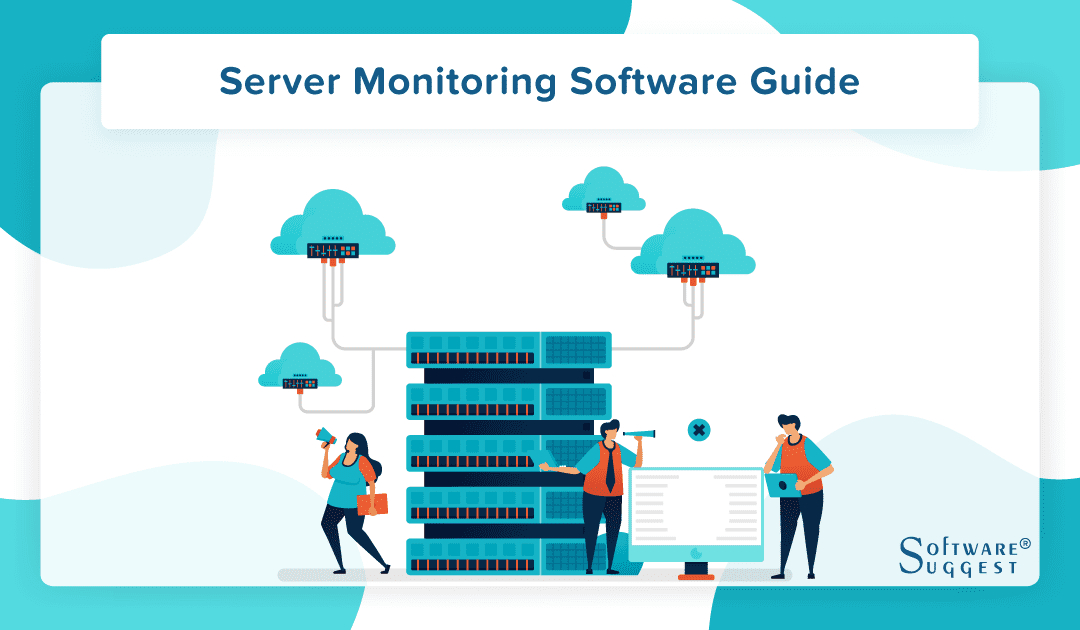
Why Use Server Monitoring Tools?
The server monitoring tool is gaining visibility into the activity on your servers — whether physical or virtual. A server is a device that stores and processes information for delivery to other devices, applications, or users.
A server can support hundreds or even thousands of requests simultaneously. Therefore, managing an organization's IT infrastructure relies heavily on ensuring all its servers work as expected.
Monitoring your servers' performance and uptime is crucial to the health of your IT infrastructure, as they are some of the most critical components of your IT infrastructure. For example, you may lose customers if your web server is offline, running slowly, or experiencing outages or other performance issues.
In addition, crucial business data, such as accounting files or customer records, may get corrupted if an internal file server generates errors. Server monitoring software is designed to monitor your systems and provide critical metrics to IT management.
What are the Benefits of Server Monitoring Tools?
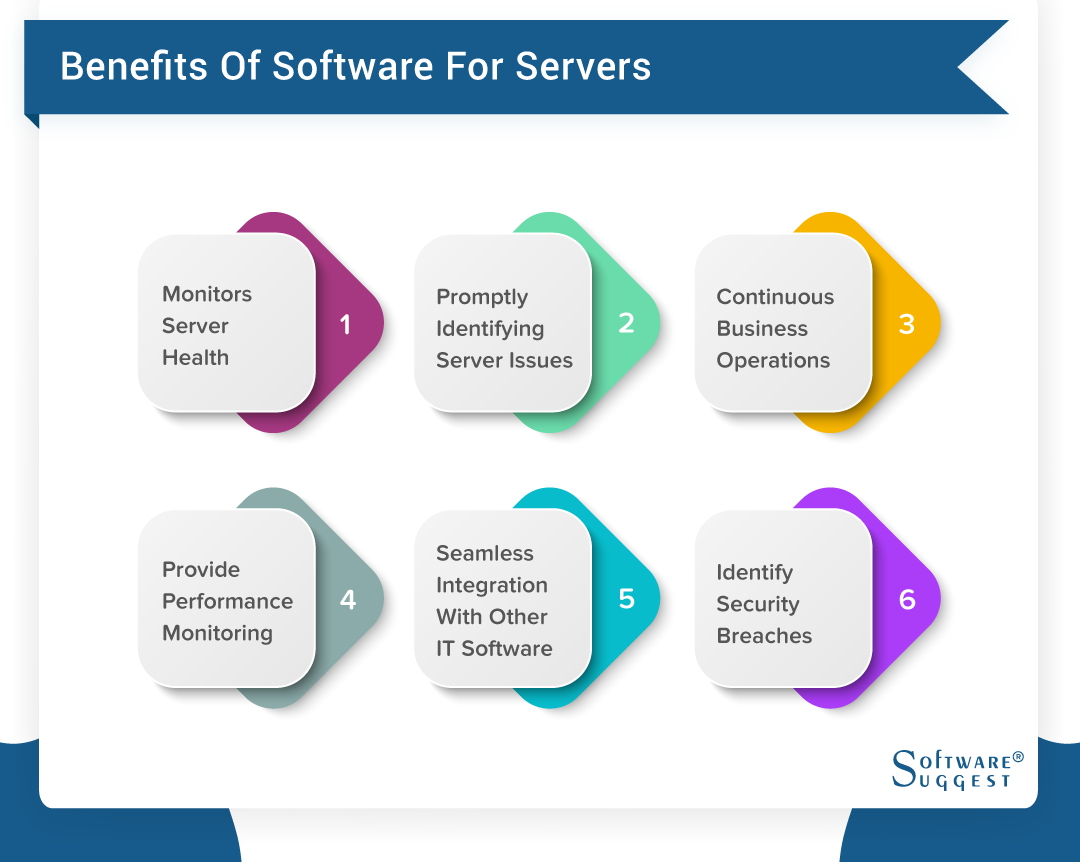
Below are the benefits of server performance monitoring tools:
-
Monitors Server Health
Server performance monitoring tools program tracks various metrics, such as CPU optimization, memory usage, disk allocation, response time, and many more.
Using this remote monitoring tool, users can keep track of all components from a vantage point, ensuring the server is healthy and no issues are causing a system slowdown.
-
Promptly Identifying Server Issues
As soon as a problem arises, real-time server monitoring software alerts the user, allowing them to be proactive.
As many businesses cannot afford downtime, which could result in substantial financial losses, this software will enable them to keep servers running at 100% efficiency without any lapses. Moreover, this allows for easier, faster troubleshooting.
-
Continuous Business Operations
Companies can run daily operations without problems by monitoring server uptime and downtime. For example, if a company website fails to function correctly and goes down, the server monitoring tools will alert the user immediately and take the necessary action.
This way, the website can be up and running quickly, preventing the company from losing website traffic.
-
Provide Performance Monitoring
A user can analyze real-time and historical data and pinpoint possible causes of system failure using performance statistics.
-
Seamless Integration With Other IT Software
IT infrastructure monitoring can seamlessly integrate various software tools, including log analysis software, IT alert systems, IT issue resolution software, etc. In addition, its data is used in collaboration with other tools to build a robust IT infrastructure ecosystem.
-
Identify Security Breaches
A sudden spike in data processing or bandwidth consumption may indicate a security breach, allowing the user to take preemptive action.
What are the Common Features of Server Monitoring Software?

Server monitoring tools are a great way to monitor the health of all your physical and virtual servers and ensure no issues could lead to downtime. Below are some metrics that help users monitor their servers:
-
CPU Utilization
Software that monitors the CPU load must be able to perform this feature efficiently. Because the CPU is the center of processing for the server, any fault or issue with CPU performance could slow down the server, eventually leading to a crash. Furthermore, heavy CPU usage will result in poor memory utilization, diminishing the server's health.
-
Disk Usage
The feature allows users to see how much disk space is left for use, identifies the applications and processes that take up the most space, and provides solutions to prevent complete disk space utilization. Using it, users can make simple and efficient decisions regarding capacity planning.
-
Network Monitoring & Analysis
As the backbone of the IT environment, servers are connected to large computer networks worldwide. Performing a manual network check across every connection point is impossible for humans to do, so software plays an important role. Network statistics can be tested, collected, processed, and built into a database to be analyzed and derived insights from.
-
Error Rate Detection & Analysis
As a percentage of total error requests, the error rate refers to the number of issues that occur. By analyzing an error rate, the user can identify possible errors before they occur, thereby preventing downtime. Even though a standard error rate of less than 1% is acceptable, ensuring that mistakes are as minimal as possible would be ideal.
-
Bandwidth Analysis
Taking up more bandwidth would slow down a server's performance. Instead, users can reduce congestion and bottlenecks and ensure that the server runs smoothly by tracking the bandwidth consumed by an application.
Three bandwidth monitoring options are available: packet sniffing, Simple Network Management Protocol (SNMP), and Netflow. The SNMP protocol is an ideal tool for monitoring bandwidth. An SNMP-based server monitoring solution gathers data or transmits and receives values through the interfaces of network devices.
Need to Consideration While Purchasing Server Monitoring Tools?
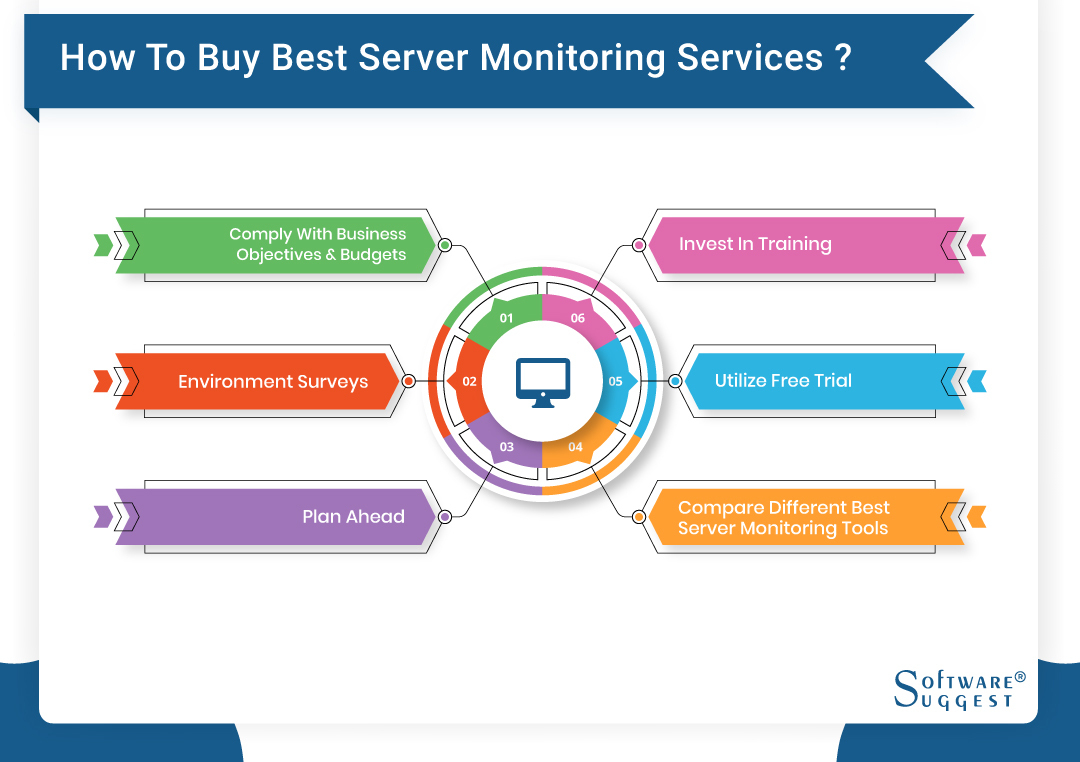
A server monitoring system service must have one common goal: monitor a server's health and alert the user when errors occur. However, there is plenty to think about before purchasing server performance monitoring tools, including:
-
Comply With Business Objectives & Budgets
When purchasing a server monitoring solution, the primary objective is to ensure it is well aligned with the buyer's business objectives and budget. For example, the buyer may opt for a free software version or a primary offering with minimal features if they only need to maintain server health.
On the other hand, it is possible to choose a more sophisticated and feature-rich server monitoring program if a buyer needs software capable of handling a wide range of operations and large advanced tasks.
-
Environment Surveys
The buyer must examine the company's IT systems and applications to choose the right software for the server. For example, buyers with several physical or virtual servers need server monitoring software to manage each server individually.
-
Plan Ahead
To accommodate current server requirements and future upgrades, buyers must choose software to support current and future promotions as companies grow and expand operations.
Therefore, it is vital to ensure hardware compatibility in the future by checking with the software vendor if the monitoring software can also provide long-term support for the buyer.
-
Compare Different Best Server Monitoring Tools
After deciding that you need server monitoring tools to keep track of server health and have a budget, the next stage would be to make a long list of the best server monitoring tools on the market. Software with long lists is eliminated if it does not provide critical functionality, resulting in a more compact, precise list.
-
Utilize a Free Trial
Following the narrowing down of the list, customers can decide whether the vendor provides a live demo or a free trial version (limited in functionality) of the server monitoring tools. It's an excellent way for buyers to determine if the server performance monitoring tools are the right choice, and they can use the trial versions before committing to the purchase.
-
Invest in Training
It is a good idea to ask the software vendor if they can train employees who will operate the software regularly when choosing new software.
Employees can become more comfortable with the server tools if software vendors provide training. As a result, employees can adapt more quickly to the server tools by reducing the learning curve.
Who Uses Server Monitor Solution?
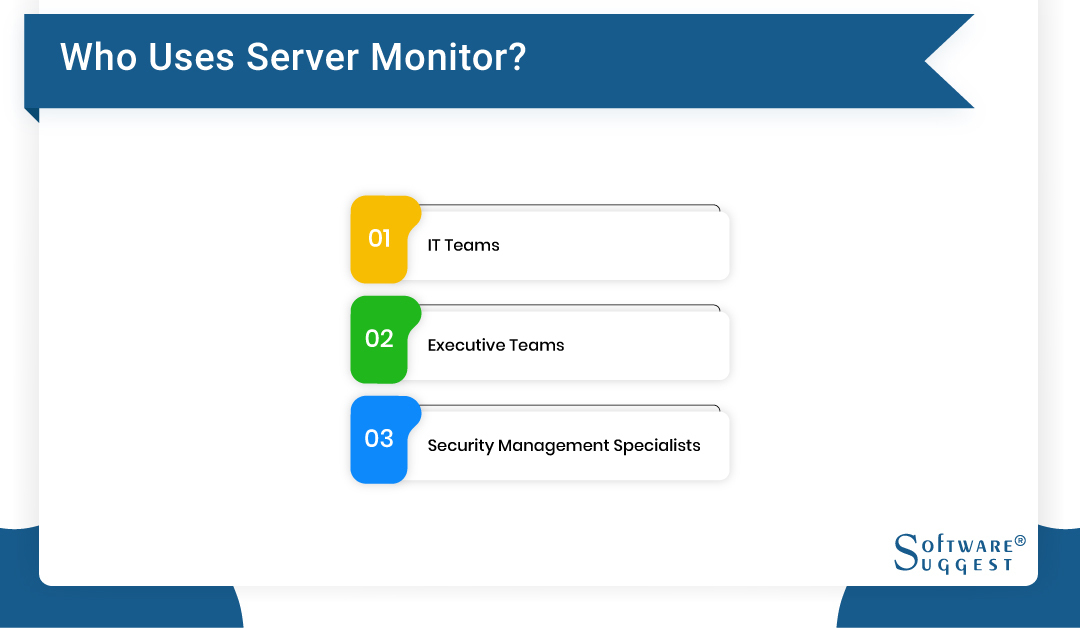
-
IT teams
Network monitoring tools alert the IT team to errors and take quick actions to reduce downtime. The alerts are sent to the server monitoring software system administrator, who then raises them with the appropriate system engineers.
Using the system engineers' expertise, they can troubleshoot and resolve application performance, hosting issues, and server functionality changes. The team will also establish performance monitoring benchmarks to maintain server efficiency.
-
Executive Teams
Business professionals can make data-driven decisions by using verified data to achieve business goals. The executive team can proactively derive insights from data visualization by using the server monitoring systems' data (via dashboards or templates or by integrating the software with other methods).
As a result, executive teams can assess risk, analyze efficiency, and track their assets' return on investment (ROI).
-
Security Management Specialists
Server monitoring solutions can help the team ensure that all web servers are secure and are not compromised by tracking the data they collect. In addition, this is extremely useful when multiple web and virtual servers need to be monitored at various locations, as the team can eliminate any risks even before they occur.
What are the Alternatives to Server Monitoring Tools?
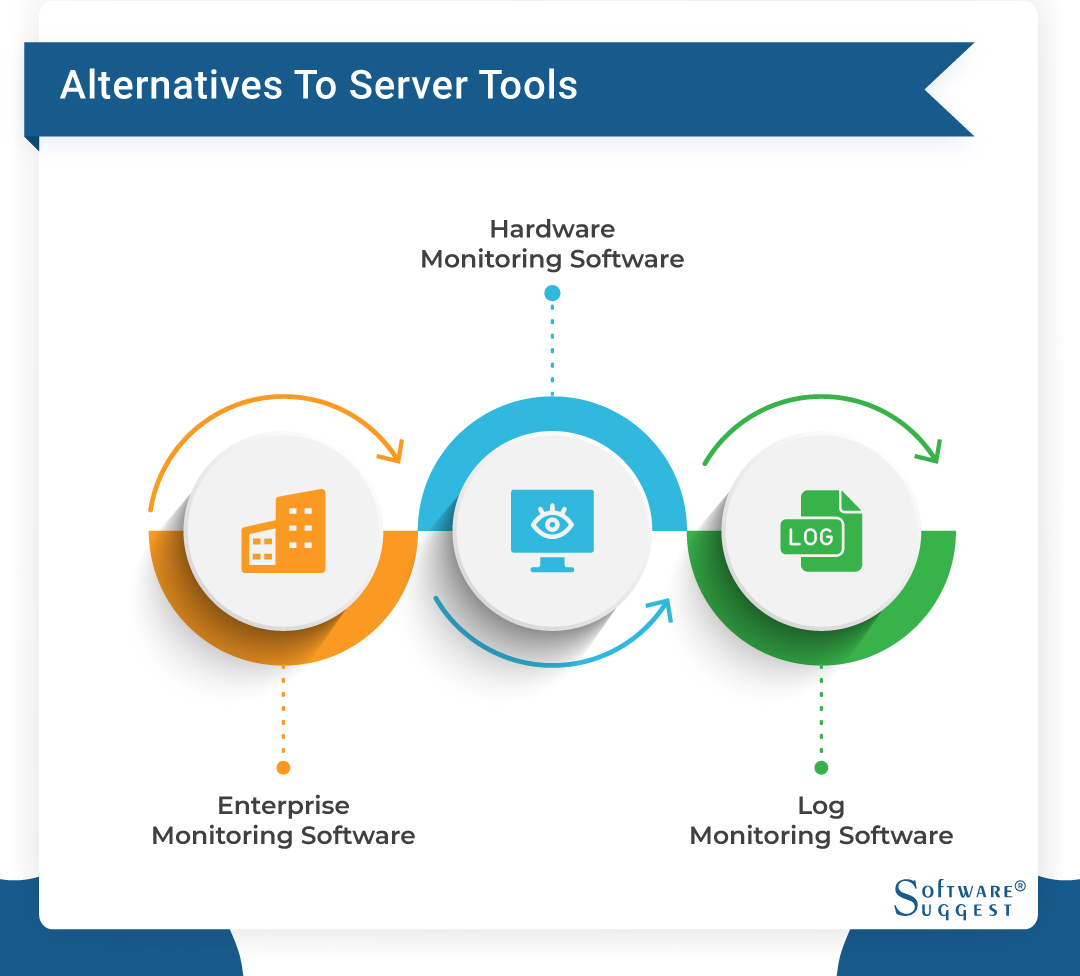
There are several alternatives to server monitoring tools, and you can use those instead of a network monitoring tool:
-
Enterprise Monitoring Software
With integrated enterprise monitoring software, all IT environments within an organization can be monitored, including servers, storage, networks, database management, etc.
You can access data via a single dashboard. Since this approach allows complete infrastructure monitoring tools, multiple users can utilize the same system instead of independently monitoring servers.
-
Hardware Monitoring Software
Hardware monitoring software tracks the performance of hardware components, such as CPU performance and fan speed, which are critical components of a server. It sends alerts in case of potential problems, allowing the user to pinpoint the source of the error and take the measures needed.
-
Log Monitoring Software
A log monitoring software scans and monitors the log files generated by servers and networks and generates alerts when abnormal patterns are detected.
What are the Challenges with Server Performance Monitoring Tools?
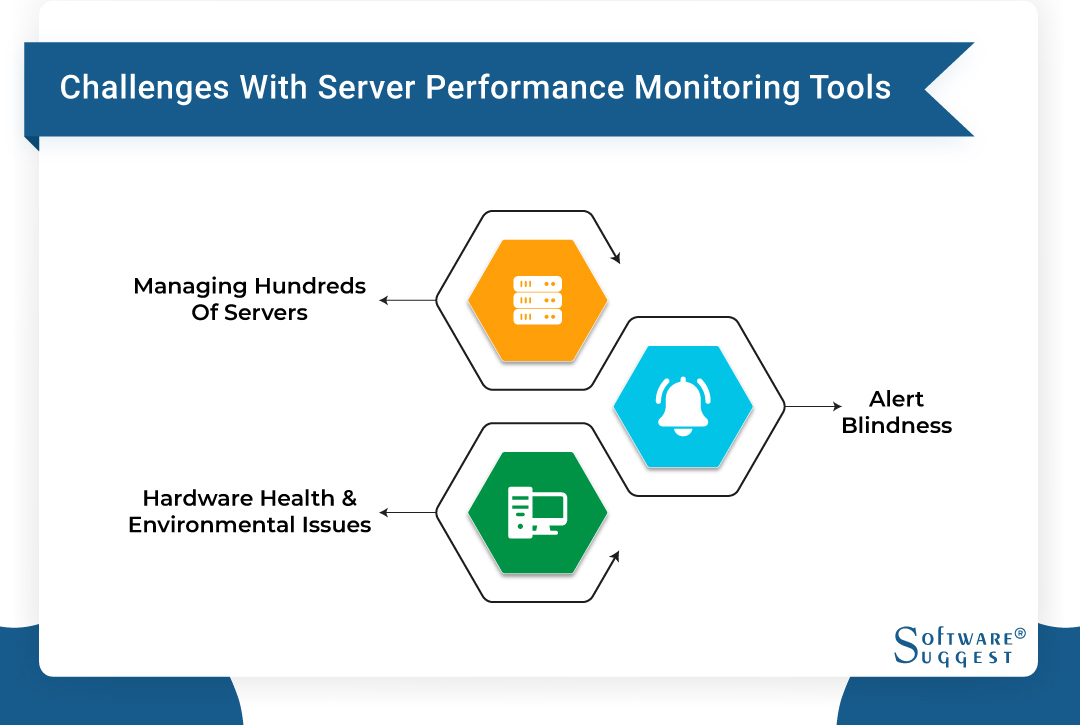
Companies encounter the following challenges when using server monitor software:
-
Managing Hundreds of Servers
The sudden need for working from home drives companies to invest heavily in server infrastructure to facilitate high-speed data processing, file transfers, and smooth operation.
However, as the number of servers increases, server monitoring service becomes more challenging to keep up with the added servers and therefore needs to be constantly updated.
-
Alert Blindness
A condition known as alert blindness happens when a user receives several alerts from a server monitoring tool that, with time, may be ignored due to their repetitive nature.
It is unlikely that users will be able to recognize severe issues that need immediate attention in such a scenario. To resolve this challenge, you can set threshold notifications for various components and retest intervals to ensure the errors are not repeated or one-time.
You can also set it up to restart servers for cases where the site is freezing automatically. For example, if a server fails, it can be set up to continue and check if the issue is resolved. If not, it can alert system administrators to troubleshoot the problem.
-
Hardware Health & Environmental Issues
In some cases, admins cannot control issues such as power outages, UPS failures, temperature, and humidity levels in a data center, cooling system failures, and fan breakdowns.
5 Best Server Monitoring Tools
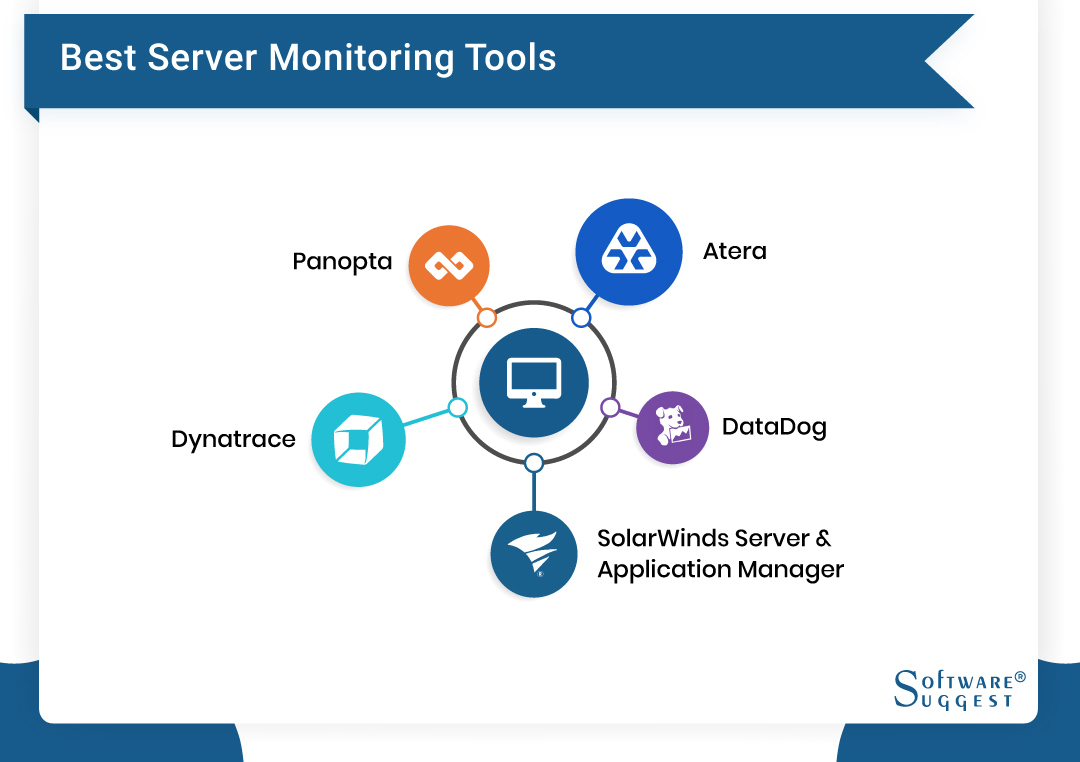
Many Windows, Mac, and Linux server monitoring tools are available today. To help you make the right choice, here are the ten best software for server monitoring:
- Atera
- DataDog
- SolarWinds Server & Application Manager
- Dynatrace
- Panopta
-
Atera
Atera is an integrated and powerful cloud-based Remote IT Management platform for managed service providers (MSPs), IT consultants, and IT departments. All servers on your managed networks can be monitored and managed using the Atera agent for a flat fee with Atera.
Moreover, Atera's Network Discovery add-on identifies unmanaged devices and opportunities instantly. Providing all-in-one IT management solutions, Atera is an integrated solution that includes everything you need.
Remote Monitoring and Management (RMM), Remote Access, Network Discovery, Reporting, Script Library, Ticketing, Helpdesk, and more are just a few features in Atera.
Features
Monitoring server availability & performance
Run automation profiles for continuous maintenance & updates
Automated self-healing alerts with real-time alerting
Pricing
Pro - $99 per user, per month billed annually
Growth - $129 per user, per month billed annually
Power - $169 per user, per month billed annually
-
DataDog
DataDog provides a unified view of monitoring your infrastructure, applications, network, and logs. One of the features of Datadog is its ability to offer correlated metrics associated with server log discovery and trace, which can be helpful when trying to troubleshoot server performance issues.
For example, When you monitor server metrics with application data, you can discover hidden sources of lag, such as overburdened servers or contested databases.DataDog's real-time Linux server monitor capabilities allow you to visualize the server's health and performance.
Features
Resolve issues quicker with ML-based insights.
Connect distributed traces to infrastructure metrics, network calls, and live processes.
Reduce service latency with a breakdown of slow requests by time spent in code on CPU, GC, lock contention, and I/O.
Pricing
Starts at $15 per host per month
-
SolarWinds Server & Application Manager
Using SolarWinds server monitoring software, you can monitor the server performance, alert any errors, report errors, manage the server, etc. In addition to monitoring the server response time, services, memory, CPU load, and event logs, SolarWinds' server management allows you to restart the server, kill processes, and restart services.
SolarWinds windows server monitoring tools cover all Microsoft products and services such as Windows Server, SQL-DB, Hyper-V, Azure, and more.
Features
Tracks the status and availability of servers
Monitors real-time processes
Resolves issues faster and minimizes downtime.
Pricing
Starts at $1,663
-
Dynatrace
The Dynatrace server performance monitoring tool offers software (SaaS) and on-premise implementations. In addition to monitoring server metrics and logs, Dynatrace can show you network metrics specific to processes. One of Dynatrace's cool features is that it can offer you network metrics specific to operations.
Features
On-premises version available
All-in-one platform for infrastructure, applications, analytics, and cloud automation
AI-powered anomaly detection and alerts
Pricing
Full-stack monitoring - Starts at $74
Infrastructure monitoring - Starts at $22
Digital experience monitoring - Starts at $11
-
Panopta
Panopta is a web-based SaaS monitoring tool that helps companies and service providers track network and server performance in the cloud, on-premises, and hybrid environments. In addition, it has a built-in incident handler that helps manage incidents and resolve issues centrally.
Using Panopta's cloud monitoring functionality, you can automatically check application performance, disk space usage, load balancers, and many other applications. In addition, OpenStack allows you to manage servers across Linux, Unix, Windows, and Mac operating systems.
Features
Availability Testing & Bandwidth Monitoring
Configuration Management
Mail Server Monitoring & Maintenance Scheduling
Pricing
Enterprise -$749
Standard - $49
Corporate - $399
Advanced - $129
FAQs
A server monitoring tool monitors the server's run quality and functions. These tools are designed to detect bugs and data analysis to look after the server and network functioning. For example, it monitors the CPU loads, error ratio, bandwidth, and disk usage.
A server's performance can be monitored manually or automatically using server monitoring tools, depending on the server type. For example, Application servers are monitored for their availability and responsiveness.
Monitoring server metrics requires server monitoring tools. You can purchase them if you don't have them or start a free trial of the above-mentioned best server monitoring tools. Here are the steps for server monitoring:
- Prepare the Server for Monitoring
- Add Server
- Add More Monitors
- Configure Runtime Statistics
- Start the Load Test
- View Statistics After the Test Run









